Leak Detection and Location of Water Pipes Using Vibration Sensors and Modified ML Prefilter
Abstract
:1. Introduction
2. Locating Leaks Using Time Difference
3. Time Difference Estimation
3.1. Conventional Time Difference Estimation Methods
3.2. Proposed Time Difference Estimation Scheme Using the Modified ML Method
4. Simulation Results
4.1. Channel Model and Optimisation of Regularisation Factor
4.2. Performance Comparison
5. Field Measurement
5.1. System Setup for Field Testing
5.2. Performance Evaluation
6. Conclusions
Acknowledgments
Author Contributions
Conflicts of Interest
References
- United States EPA Office of Water. Control and Mitigation of Drinking Water Losses in Distribution Systems. Available online: https://nepis.epa.gov/ (accessed on 20 July 2017).
- BDEW German Association of Energy and Water Industries. VEWA Survey—Comparison of European Water and Wastewater Prices. Available online: https://www.bdew.de/ (accessed on 20 July 2017).
- Ministry of Environment, Republic of Korea. 2015 Statistics of Waterworks. Available online: http://me.go.kr/ (accessed on 30 June 2017).
- Puust, R.; Kapelan, Z.; Savic, D.A.; Koppel, T. A Review of Methods for Leakage Management in Pipe Networks. Urban Water J. 2010, 7, 25–45. [Google Scholar] [CrossRef]
- Martini, A.; Troncossi, M.; Rivola, A. Automatic Leak Detection in Buried Plastic Pipes of Water Supply Networks by Means of Vibration Measurements. Shock Vib. 2015, 2015, 1–13. [Google Scholar] [CrossRef]
- Liston, D.A.; Liston, J.D. Leak Detection Techniques. J. N. Engl. Water Works Assoc. 1992, 106, 103–108. [Google Scholar]
- Hunaidi, O. Detecting leaks in water-distribution pipes. Constr. Technol. Updates 2000, 40, 1–6. [Google Scholar]
- Hunaidi, O.; Chu, W.; Wang, A.; Guan, W. Detecting leaks in plastic pipes. J. Am. Water Works Assoc. 2000, 92, 82–94. [Google Scholar]
- Mounce, S.R.; Boxall, J.B.; Machell, J. Development and Verification of an Online Artificial Intelligence System for Detection of Bursts and Other Abnormal Flows. J. Water Resour. Plan. Manag. 2010, 136, 309–318. [Google Scholar] [CrossRef]
- Furthermoreersen, J.H.; Powell, R.S. Implicit State-Estimation Technique for Water Network Monitoring. Urban Water 2000, 2, 123–130. [Google Scholar] [CrossRef]
- Poulakis, Z.; Valougeorgis, D.; Papadimitriou, C. Leakage Detection in Water Pipe Networks Using a Bayesian Probabilistic Framework. Probab. Eng. Mech. 2003, 18, 315–327. [Google Scholar] [CrossRef]
- Goulet, J.A.; Coutu, S.; Smith, I.F. Model Falsification Diagnosis and Sensor Placement for Leak Detection in Pressurized Pipe Networks. Adv. Eng. Inf. 2013, 27, 261–269. [Google Scholar] [CrossRef]
- Moser, G.; Paal, S.G.; Smith, I.F. Performance Comparison of Reduced Models for Leak Detection in Water Distribution Networks. Adv. Eng. Inf. 2015, 29, 714–726. [Google Scholar] [CrossRef]
- Ayala–Cabrera, D.; Herrera, M.; Izquierdo, J.; Ocaña–Levario, S.J.; Pérez–García, R. GPR-Based Water Leak Models in Water Distribution Systems. Sensors 2013, 13, 15912–15936. [Google Scholar] [CrossRef]
- Cataldo, A.; Cannazza, G.; Benedetto, E.D.; Giaquinto, N. A New Method for Detecting Leaks in Underground Water Pipelines. IEEE Sens. J. 2012, 12, 1660–1667. [Google Scholar] [CrossRef]
- Giaquinto, N.; D’Aucelli, G.M.; Benedetto, E.D.; Cannazza, G.; Cataldo, A.; Piuzzi, E.; Masciullo, A. Criteria for Automated Estimation of Time of Flight in TDR Analysis. IEEE Trans. Instrum. Meas. 2016, 65, 1215–1224. [Google Scholar] [CrossRef]
- Hunaidi, O.; Wang, A.; Bracken, M. Acoustic Methods for Locating Leaks in Municipal Water Pipe Networks. In Proceedings of the International Conference Water Demand Management, Dead Sea, Jordan, 30 May–3 June 2004; pp. 1–14. [Google Scholar]
- Knapp, C.; Carter, G. The Generalized Correlation Method for Estimation of Time Delay. IEEE Trans. Acoust. Speech Signal Process. 1976, 24, 320–327. [Google Scholar] [CrossRef]
- Hero, A.; Schwartz, S. A New Generalized Cross Correlator. IEEE Trans. Acoust. Speech Signal Process. 1985, 33, 38–45. [Google Scholar] [CrossRef]
- Carter, G.C. Coherence and Time Delay Estimation. Proc. IEEE 1987, 75, 236–255. [Google Scholar] [CrossRef]
- Gao, Y.; Brennan, M.; Joseph, P. A Comparison of Time Delay Estimators for the Detection of Leak Noise Signals in Plastic Water Distribution Pipes. J. Sound Vib. 2006, 292, 552–570. [Google Scholar] [CrossRef]
- Lay-Ekuakille, A.; Vendramin, G.; Trotta, A.; Vanderbemden, P. STFT-Based Spectral Analysis of Urban Waterworks Leakage Detection. In Proceedings of the XIX IMEKO World Congress Fundamental and Applied Metrology, Lisbon, Portugal, 6–11 September 2009. [Google Scholar]
- Ge, C.; Yang, H.; Ye, H.; Wang, G. A Fast Leak Locating Method Based on Wavelet Transform. Tsinghua Sci. Technol. 2009, 14, 551–555. [Google Scholar] [CrossRef]
- Zhang, L.; Wu, Y.; Guo, L.; Cai, P. Design and Implementation of Leak Acoustic Signal Correlator for Water Pipelines. Inf. Technol. J. 2013, 12, 2195–2200. [Google Scholar] [CrossRef]
- Yang, J.; Wen, Y.; Li, P. Information Processing for Leak Detection on Underground Water Supply Pipelines. In Proceedings of the 3rd International Workshop on Advanced Computational Intelligence, Suzhou, China, 25–27 August 2010; pp. 623–629. [Google Scholar]
- Kadri, A.; Yaacoub, E.; Mushtaha, M. Empirical Evaluation of Acoustical Signals for Leakage Detection in Underground Plastic Pipes. In Proceedings of the 17th IEEE Mediterranean Electrotechnical Conference, Beirut, Lebanon, 13–16 April 2014; pp. 54–58. [Google Scholar]
- Ahadi, M.; Bakhtiar, M.S. Leak Detection in Water-Filled Plastic Pipes Through the Application of Tuned Wavelet Transforms to Acoustic Emission Signals. Appl. Acoust. 2010, 71, 634–639. [Google Scholar] [CrossRef]
- Rashid, S.; Qaisar, S.; Saeed, H.; Felemban, E. A Method for Distributed Pipeline Burst and Leakage Detection in Wireless Sensor Networks Using Transform Analysis. Int. J. Distrib. Sens. Netw. 2014, 10, 1–14. [Google Scholar] [CrossRef]
- Bentoumi, M.; Chikouche, D.; Mezache, A.; Bakhti, H. Wavelet DT Method for Water Leak-Detection Using a Vibration Sensor: An Experimental Analysis. IET Signal Process. 2017, 11, 396–405. [Google Scholar] [CrossRef]
- Lay-Ekuakille, A.; Vendramin, G.; Trotta, A. Robust Spectral Leak Detection of Complex Pipelines Using Filter Diagonalization Method. IEEE Sens. J. 2009, 9, 1605–1614. [Google Scholar] [CrossRef]
- Almazyad, A.S.; Seddiq, Y.M.; Alotaibi, A.M.; Al-Nasheri, A.Y.; BenSaleh, M.S.; Obeid, A.M.; Qasim, S.M. A Proposed Scalable Design and Simulation of Wireless Sensor Network-Based Long-Distance Water Pipeline Leakage Monitoring System. Sensors 2014, 14, 3557–3577. [Google Scholar] [CrossRef] [PubMed]
- Shi, Y.; Zhang, C.; Li, R.; Cai, M.; Jia, G. Theory and Application of Magnetic Flux Leakage Pipeline Detection. Sensors 2015, 15, 31036–31055. [Google Scholar] [CrossRef] [PubMed]
- Muggleton, J.M.; Brennan, M.J.; Pinnington, R.J. Wavenumber Prediction of Waves in Buried Pipes for Water Leak Detection. J. Sound Vib. 2002, 249, 939–954. [Google Scholar] [CrossRef]
- Jackets, T. The Newton-Laplace Equation and Speed of Sound. 2014. Available online: https://www.thermaxxjackets.com/newton-laplace-equation-sound-velocity/ (accessed on 20 July 2017).
- Yoon, D.J.; Lee, Y.; Kim, Y.; Kim, C.; Jung, J.C.; Kim, S.M.; Lee, J.; Jeon, H.; Moon, C.; Kim, E.C. Development of Leak Detection System for Waterworks Using Elastic Wave; Technical Report of Korea Research Institute of Standards and Science (KRISS); Korea Research Institute of Standards and Science: Daejeon, Korea, 2004; pp. 1–263. [Google Scholar]
- Carter, G.C. Time Delay Estimation. Ph.D. Thesis, The University of Connecticut, Storrs, CT, USA, 1976. [Google Scholar]
- Hayes, M.H. Statistical Digital Signal Processing and Modeling; John Wiley & Sons, Inc.: New York, NY, USA, 1996. [Google Scholar]
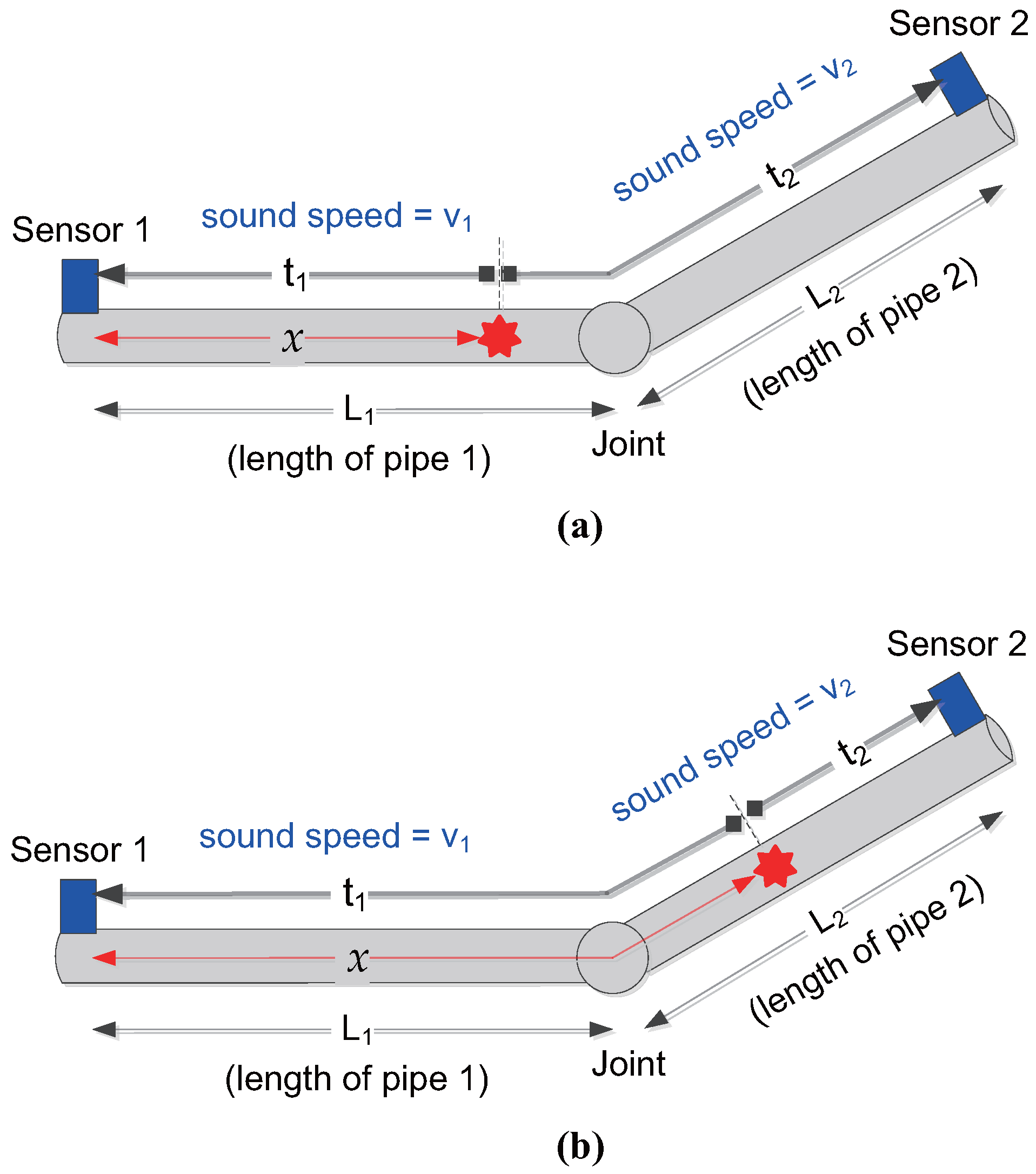


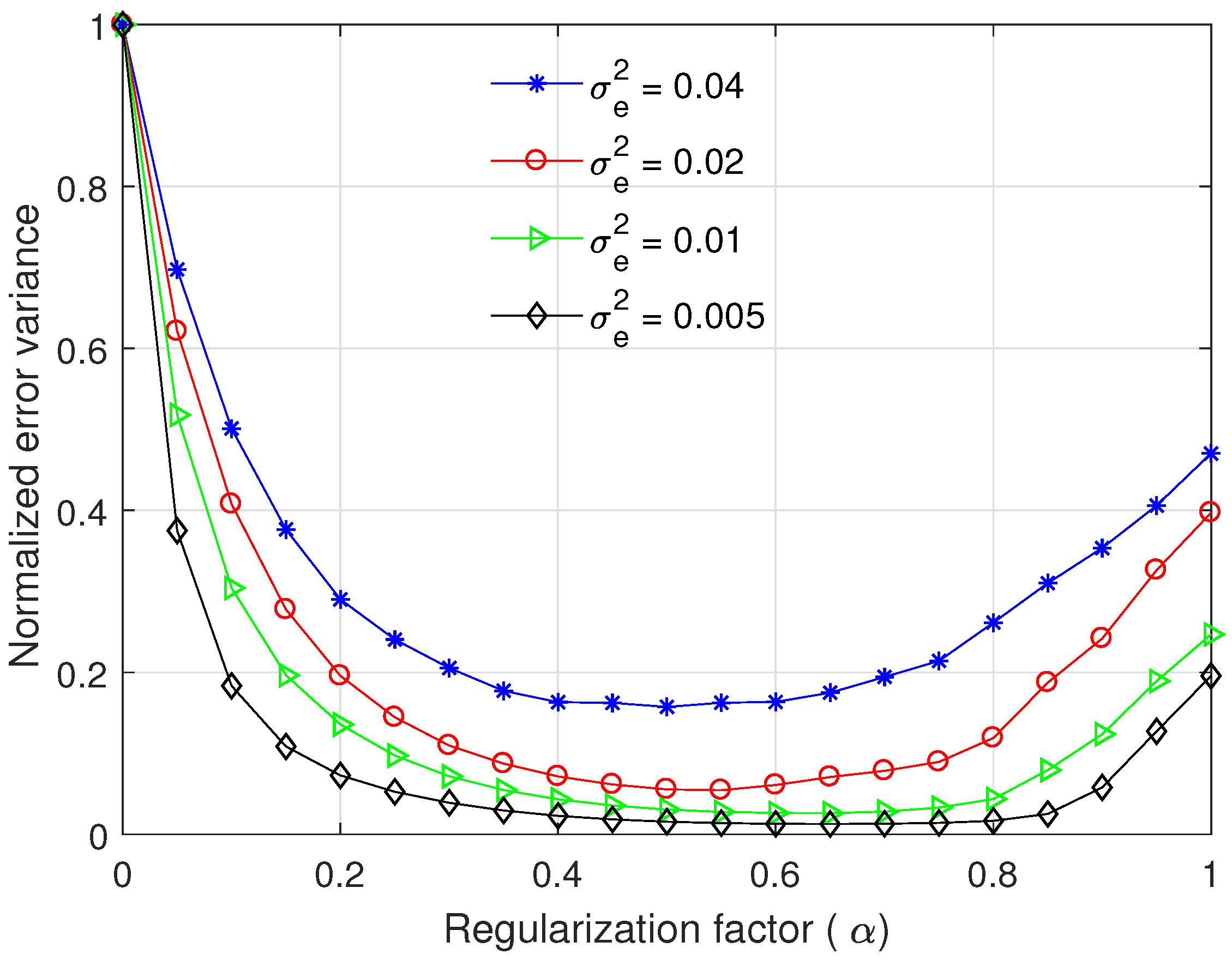


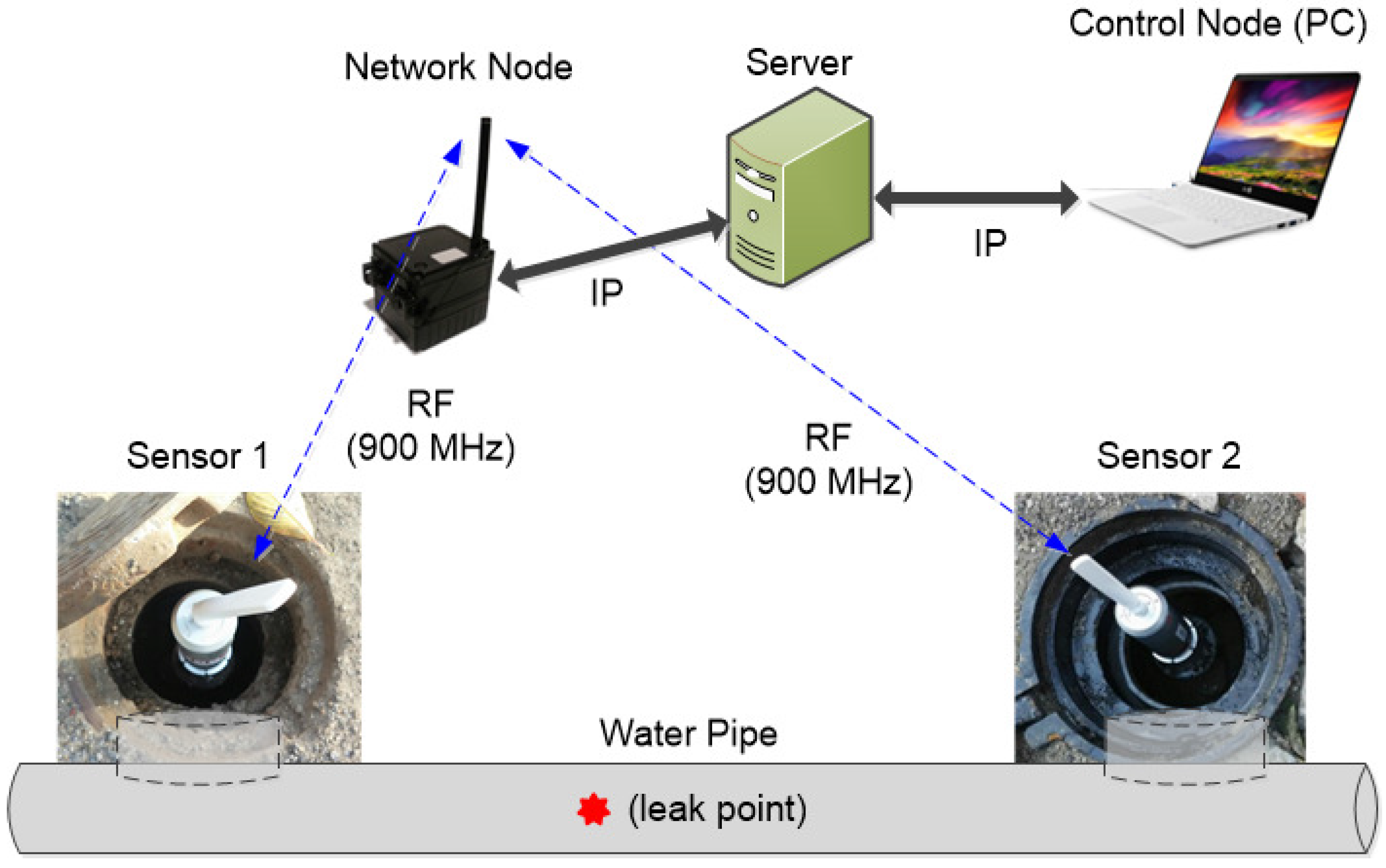
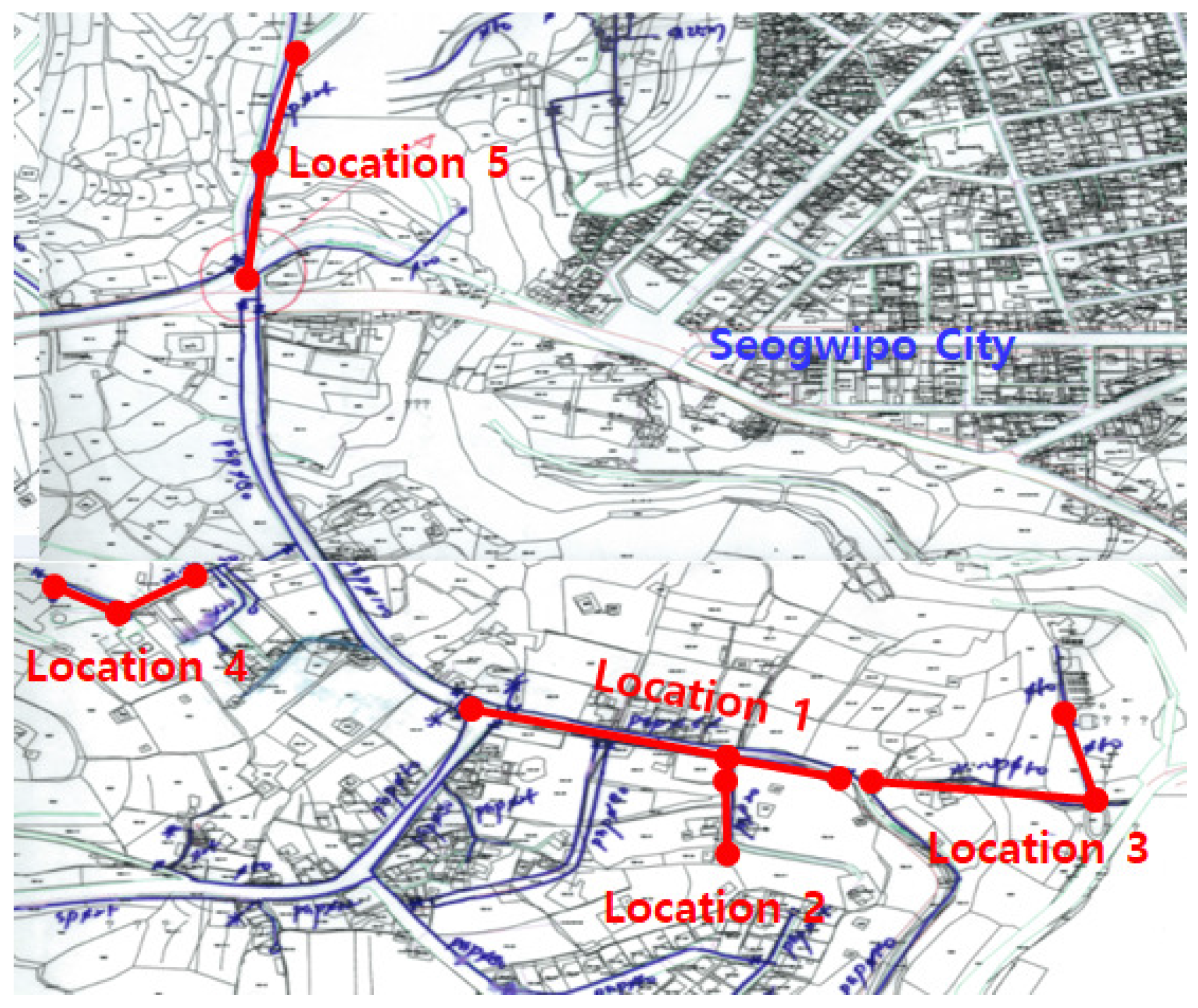
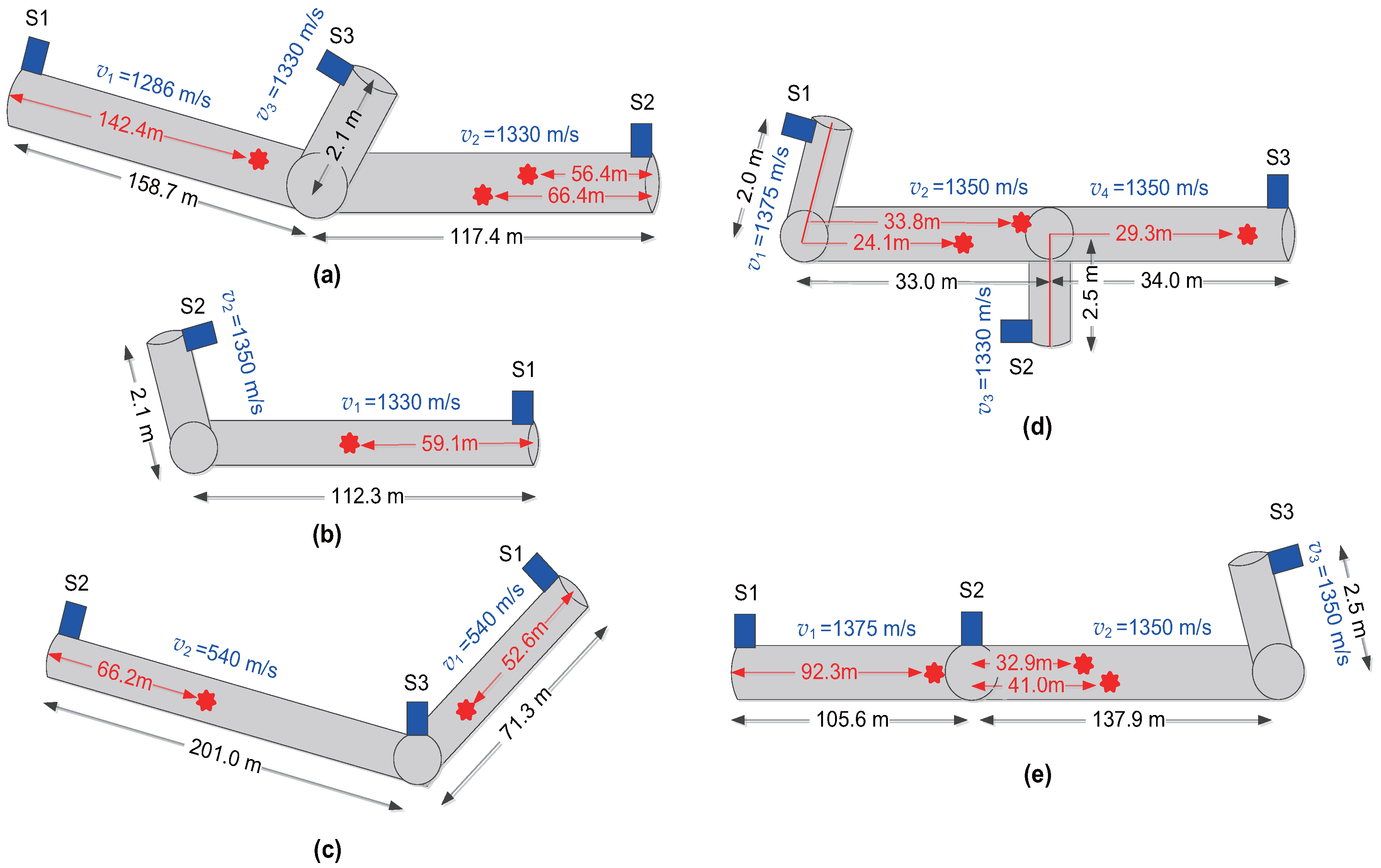

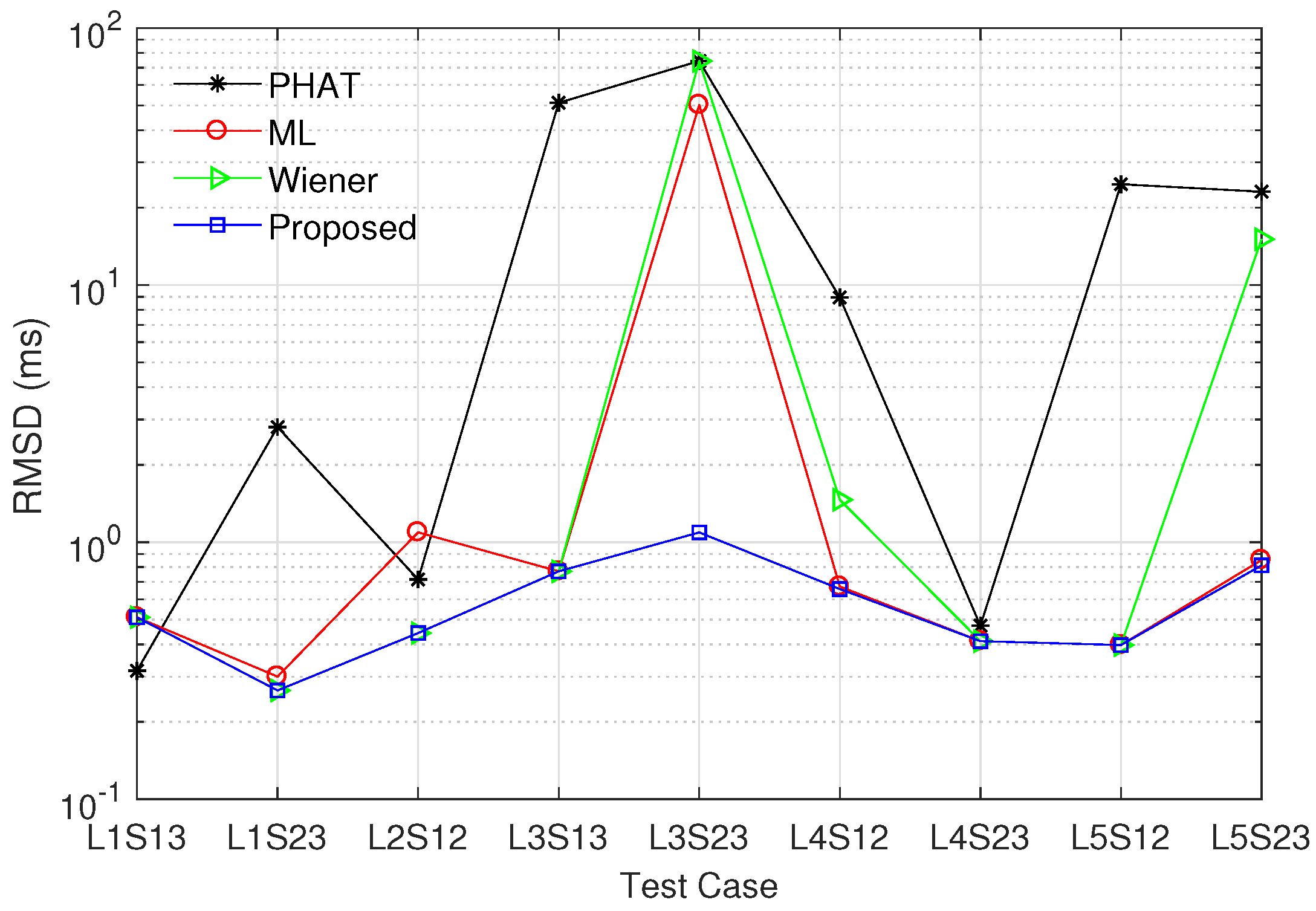
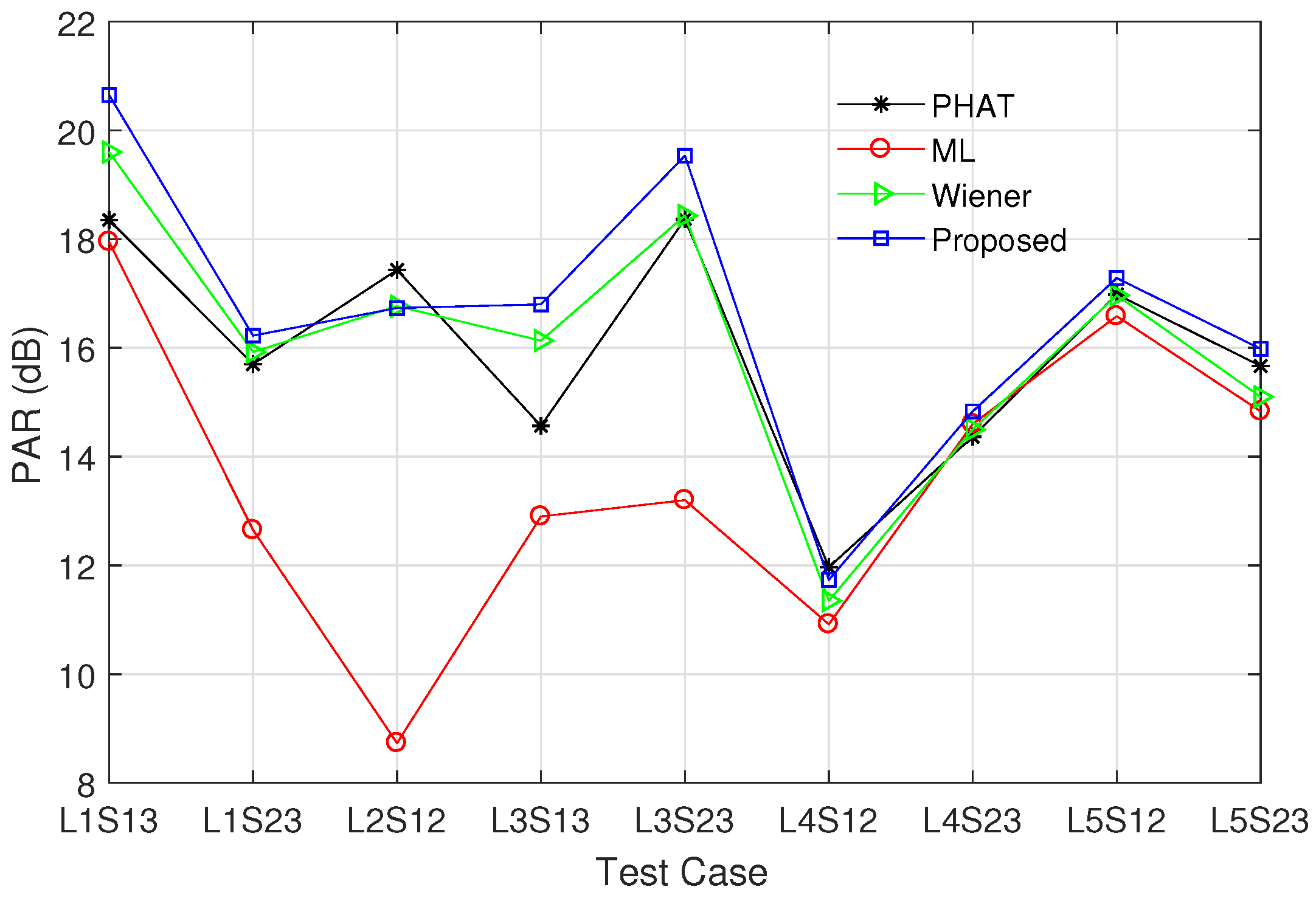
| Material | Diameter (mm) | Velocity (m/s) |
|---|---|---|
| 40 | 565 | |
| Polyvinyl Chloride (PVC) | 80 | 540 |
| 150 | 530 | |
| 150 | 1220 | |
| Cast-Iron | 250 | 1160 |
| 350 | 1120 | |
| 25 | 1375 | |
| 40 | 1350 | |
| Steel | 60 | 1330 |
| 90 | 1286 | |
| 150 | 1200 | |
| 250 | 1150 |
| Prefilter Type | Weight Function |
|---|---|
| Roth | |
| Smoothed coherence transform (SCOT) | |
| Phase transform (PHAT) | |
| Eckart | |
| Wiener | |
| Maximum-likelihood (ML) |
| Test Case | L1S13 | L1S23 | L2S12 | L3S13 | L3S23 | L4S12 | L4S23 | L5S12 | L5S23 |
|---|---|---|---|---|---|---|---|---|---|
| Location | 1 | 1 | 2 | 3 | 3 | 4 | 4 | 5 | 5 |
| Sensor Pair | S1, S3 | S2, S3 | S1, S2 | S1, S3 | S2, S3 | S1, S2 | S2, S3 | S1, S2 | S2, S3 |
| Test Case | L1S23 | L2S12 | L3S23 | L4S12 | L5S12 |
|---|---|---|---|---|---|
| Optimal | 0.35 | 0.40 | 0.60 | 0.35 | 0.45 |
© 2017 by the authors. Licensee MDPI, Basel, Switzerland. This article is an open access article distributed under the terms and conditions of the Creative Commons Attribution (CC BY) license (http://creativecommons.org/licenses/by/4.0/).
Share and Cite
Choi, J.; Shin, J.; Song, C.; Han, S.; Park, D.I. Leak Detection and Location of Water Pipes Using Vibration Sensors and Modified ML Prefilter. Sensors 2017, 17, 2104. https://doi.org/10.3390/s17092104
Choi J, Shin J, Song C, Han S, Park DI. Leak Detection and Location of Water Pipes Using Vibration Sensors and Modified ML Prefilter. Sensors. 2017; 17(9):2104. https://doi.org/10.3390/s17092104
Chicago/Turabian StyleChoi, Jihoon, Joonho Shin, Choonggeun Song, Suyong Han, and Doo Il Park. 2017. "Leak Detection and Location of Water Pipes Using Vibration Sensors and Modified ML Prefilter" Sensors 17, no. 9: 2104. https://doi.org/10.3390/s17092104





